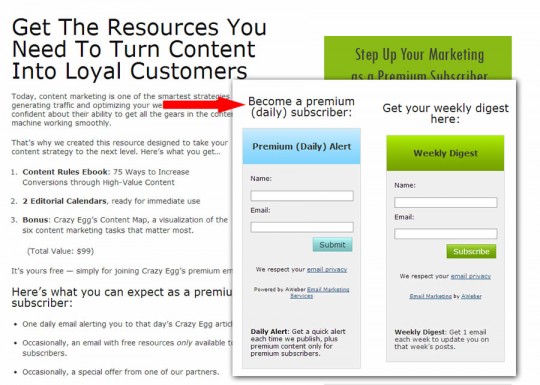How Top Conversion Experts Seduce You Into Giving Up Your Email
These days, almost every website wants your email address. It might be for a newsletter, for blog updates, or special offers… whatever the reason, these site owners know that a good email list is a critically important business asset.
But, how do you get visitors to subscribe? In these days of overstuffed inboxes, there’s surprising resistance to giving up one’s email. So, we looked to the top conversion experts in the world to find their secrets for turning casual visitors into subscribers.
Why pick these sites? It’s simple: these conversion pros have at their disposal all of the tools for testing alternative designs and techniques, along with (in most cases) years of experience in optimizing other people’s sites. Most have conducted hundreds or thousands of tests for both clients and their own sites, and have a great sense for what works in a given situation. So, let’s check in with the experts:
Bryan and Jeffrey Eisenberg
The Eisenbergs were talking about conversion long before it was fashionable, and their approach to subscriptions is state of the art. The duo’s branding focuses on Bryan, and BryanEisenberg.com starts with a massive title and an image of Bryan gazing directly at the visitor:
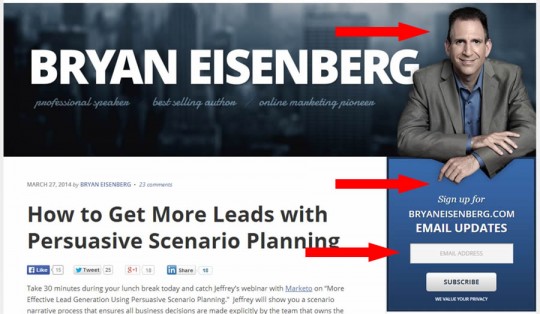
The call to action for subscriptions is a simple but prominent box just below the header. It asks just for an email address. A subtle but clever element is the positioning of Bryan’s image. It overlaps the subscription box to draw the eye into it and offers another visual nudge: his left hand’s index finger is pointing to the box.
The next nudge to subscribe comes in the form of an exit-intent driven light-box popup:
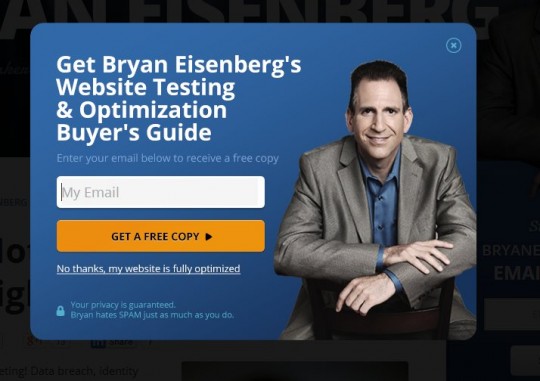
This popup matches the style of the site, complete with the same image, but varies the offer. In this case, a free buyer’s guide is offered. A nice touch is the link to close the popup, which reads, “No, my website is fully optimized.”
Crazy Egg Blog
Crazy Egg and founder Neil Patel understand visitor behavior – after all, Crazy Egg is a heat-map tool used by conversion experts to study how visitors interact with websites. They take one of the more unique approaches to getting you to subscribe to their blog. Converting at the Crazy Egg Blog starts off simply – the top of the page has an easy-to-miss subscription form just below another call to action for their heat map tool:
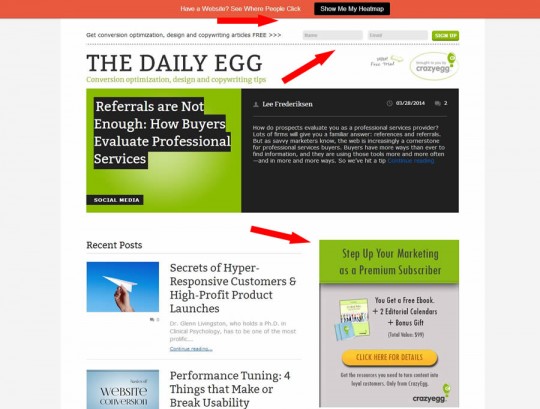
There’s also a fairly conventional sidebar ad for subscriptions, this one featuring a “Click Here for Details” button instead of a form. And, this ad includes some free items as inducements to subscribe.
Click that button, and Crazy Egg’s approach gets interesting. Instead of taking the visitor to a simple form with minimal text, it leads to a full-blown sales page describing at length both the free downloads and the benefits of becoming a “premium” subscriber (a “$99 value!”).
Premium subscribers get daily updates and the bonus items. The page also offers a weekly option without the bonus items.
 Why go through all this for a subscription? My take is that it explicitly gets visitors to sign up for and expect daily updates. This is far higher frequency than most blogs, but having a list of opt-in daily subscribers is a big advantage for Crazy Egg. They can promote their own products, of course, but also have plenty of opportunities for advertising and affiliate offers.
Why go through all this for a subscription? My take is that it explicitly gets visitors to sign up for and expect daily updates. This is far higher frequency than most blogs, but having a list of opt-in daily subscribers is a big advantage for Crazy Egg. They can promote their own products, of course, but also have plenty of opportunities for advertising and affiliate offers.
The process Crazy Egg uses to sign up subs may cut their initial conversion rate a bit but it also reduces quick unsubscribes or, even worse, unhappy subscribers flagging the daily esmail as spam. (It’s possible, too, that the lengthy copy, though unusual for a free subscription, actually increases conversion.)
And, unsurprisingly, there’s also a timed lightbox popup. The popup, like the header nudge, allows visitors to enter their name and email directly.
There’s a lot going on at Crazy Egg – their main website is focused on converting heat map trials, so there’s entirely different set of nudges there.
Peep Laja and Conversion XL
When you arrive at ConversionXL.com, you can’t miss the nudge to subscribe. Why? Because it’s the ONLY thing you see:
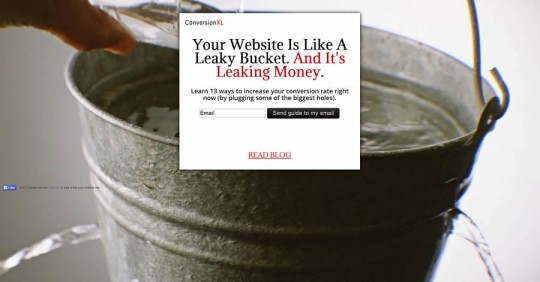
Actually, the offer doesn’t emphasize the subscription – the copy describes a free download, which, as the confirmation email clarifies, also includes subscribing to the mailing list.
Assuming you weren’t persuaded by that full-screen pitch, there’s more in store. Blog pages all have a simple but prominent call to download (and subscribe) at the top of the sidebar:
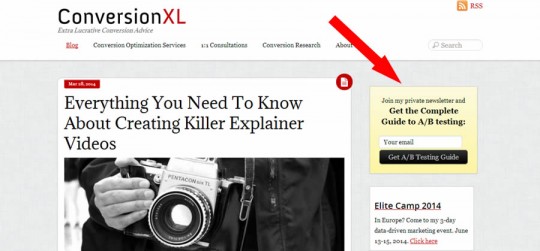
But wait, there’s more! Scroll down to read more content, and as the top box disappears, a small slide popup appears at the bottom of the sidebar to take its place. It’s not intrusive and doesn’t block the content.
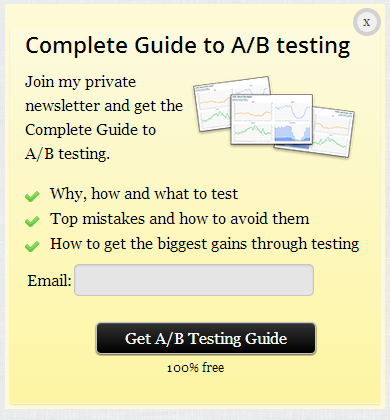
This box does offer more reasons to subscribe than the box at the top.
If you have been able to resist Peep’s charms so far, there’s one more opportunity for you to connect. Triggered either by time or apparent exit intent, a huge overlay makes sure you really don’t want to subscribe.
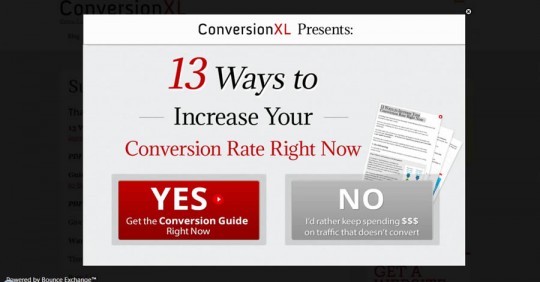
The “No” button is the same size as the “Yes” button but is visually de-emphasized so that it blends into the background. We observed several versions of this popup, and to decline this one you click a button that says, “No, I’d rather keep spending $$$ on traffic that doesn’t convert.” Who’s going to agree with that?
Get More, Free!
 If you like these real-world expert examples, you can get more free in my 40-page ebook, List-Building Secrets of the World’s Top Conversion Experts. How? For a limited time, we’re offering this ebook free to anyone who joins the 30,000-plus subscribers to my Neuromarketing updates. (Existing Neuromarketing subscribers have already received the download link.)
If you like these real-world expert examples, you can get more free in my 40-page ebook, List-Building Secrets of the World’s Top Conversion Experts. How? For a limited time, we’re offering this ebook free to anyone who joins the 30,000-plus subscribers to my Neuromarketing updates. (Existing Neuromarketing subscribers have already received the download link.)
In the ebook, we look at a dozen sites in total, exposing and analyzing the tools these experts use to build their lists. Experts include masters of online persuasion like Chris Goward, Noah Kagan, Brian Massey, Nathalie Nahai, Rich Page, and more!
Grab the ebook for free, while you still can! Enter your email address in the form below (yes, this is my approach to seduction!), and learn by example from the best in the world!

